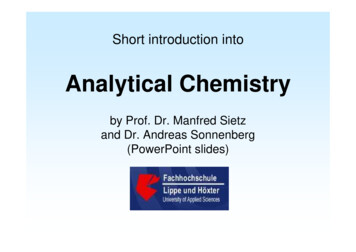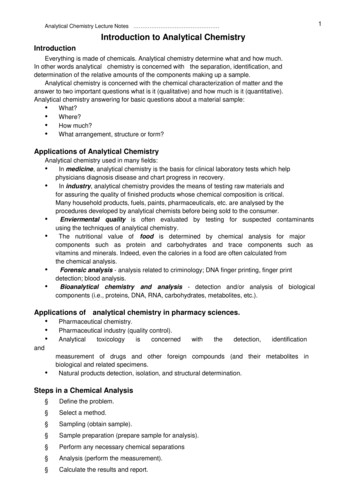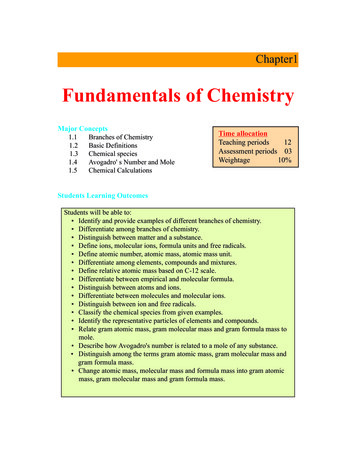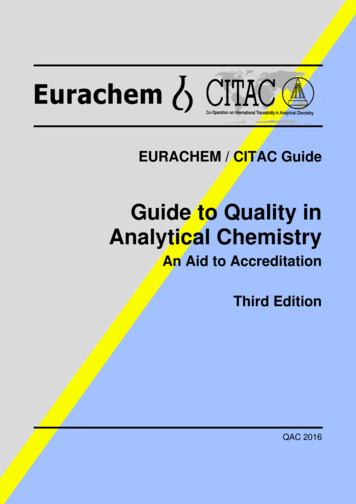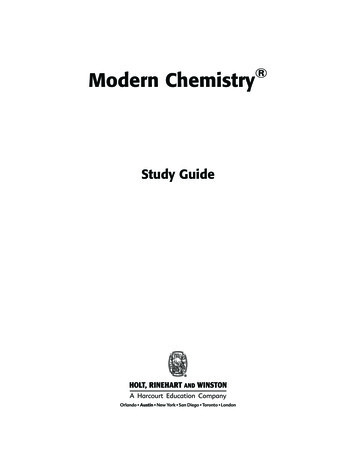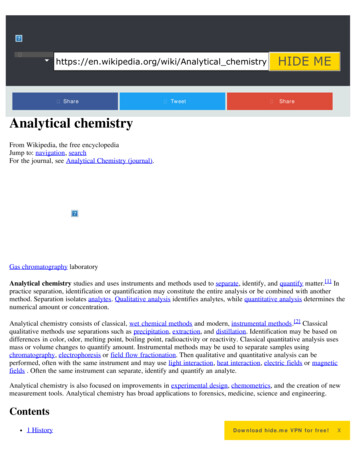
Transcription
HIDE MEhttps://en.wikipedia.org/wiki/Analytical chemistry Share Tweet ShareAnalytical chemistryFrom Wikipedia, the free encyclopediaJump to: navigation, searchFor the journal, see Analytical Chemistry (journal).Gas chromatography laboratoryAnalytical chemistry studies and uses instruments and methods used to separate, identify, and quantify matter.[1] Inpractice separation, identification or quantification may constitute the entire analysis or be combined with anothermethod. Separation isolates analytes. Qualitative analysis identifies analytes, while quantitative analysis determines thenumerical amount or concentration.Analytical chemistry consists of classical, wet chemical methods and modern, instrumental methods.[2] Classicalqualitative methods use separations such as precipitation, extraction, and distillation. Identification may be based ondifferences in color, odor, melting point, boiling point, radioactivity or reactivity. Classical quantitative analysis usesmass or volume changes to quantify amount. Instrumental methods may be used to separate samples usingchromatography, electrophoresis or field flow fractionation. Then qualitative and quantitative analysis can beperformed, often with the same instrument and may use light interaction, heat interaction, electric fields or magneticfields . Often the same instrument can separate, identify and quantify an analyte.Analytical chemistry is also focused on improvements in experimental design, chemometrics, and the creation of newmeasurement tools. Analytical chemistry has broad applications to forensics, medicine, science and engineering.Contents1 HistoryDownload hide.me VPN for free!X
2 Classical methods2.1 Qualitative analysis2.1.1 Chemical tests2.1.2 Flame test2.2 Quantitative analysis2.2.1 Gravimetric analysis2.2.2 Volumetric analysis3 Instrumental methods3.1 Spectroscopy3.2 Mass spectrometry3.3 Electrochemical analysis3.4 Thermal analysis3.5 Separation3.6 Hybrid techniques3.7 Microscopy3.8 Lab-on-a-chip4 Errors5 Standards5.1 Standard curve5.2 Internal standards5.3 Standard addition6 Signals and noise6.1 Thermal noise6.2 Shot noise6.3 Flicker noise6.4 Environmental noise6.5 Noise reduction7 Applications8 See also9 References10 Further reading11 External linksHistory[edit]Gustav Kirchhoff (left) andRobert Bunsen (right)
Analytical chemistry has been important since the early days of chemistry, providing methods for determining whichelements and chemicals are present in the object in question. During this period significant contributions to analyticalchemistry include the development of systematic elemental analysis by Justus von Liebig and systematized organicanalysis based on the specific reactions of functional groups.The first instrumental analysis was flame emissive spectrometry developed by Robert Bunsen and Gustav Kirchhoffwho discovered rubidium (Rb) and caesium (Cs) in 1860.[3]Most of the major developments in analytical chemistry take place after 1900. During this period instrumental analysisbecomes progressively dominant in the field. In particular many of the basic spectroscopic and spectrometrictechniques were discovered in the early 20th century and refined in the late 20th century.[4]The separation sciences follow a similar time line of development and also become increasingly transformed into highperformance instruments.[5] In the 1970s many of these techniques began to be used together as hybrid techniques toachieve a complete characterization of samples.Starting in approximately the 1970s into the present day analytical chemistry has progressively become more inclusiveof biological questions (bioanalytical chemistry), whereas it had previously been largely focused on inorganic or smallorganic molecules. Lasers have been increasingly used in chemistry as probes and even to initiate and influence a widevariety of reactions. The late 20th century also saw an expansion of the application of analytical chemistry fromsomewhat academic chemical questions to forensic, environmental, industrial and medical questions, such as inhistology.[6]Modern analytical chemistry is dominated by instrumental analysis. Many analytical chemists focus on a single type ofinstrument. Academics tend to either focus on new applications and discoveries or on new methods of analysis. Thediscovery of a chemical present in blood that increases the risk of cancer would be a discovery that an analyticalchemist might be involved in. An effort to develop a new method might involve the use of a tunable laser to increasethe specificity and sensitivity of a spectrometric method. Many methods, once developed, are kept purposely static sothat data can be compared over long periods of time. This is particularly true in industrial quality assurance (QA),forensic and environmental applications. Analytical chemistry plays an increasingly important role in thepharmaceutical industry where, aside from QA, it is used in discovery of new drug candidates and in clinicalapplications where understanding the interactions between the drug and the patient are critical.Classical methods[edit]The presence of copper in thisqualitative analysis is indicatedby the bluish-green color ofthe flameAlthough modern analytical chemistry is dominated by sophisticated instrumentation, the roots of analytical chemistryand some of the principles used in modern instruments are from traditional techniques many of which are still used
today. These techniques also tend to form the backbone of most undergraduate analytical chemistry educational labs.Qualitative analysis[edit]A qualitative analysis determines the presence or absence of a particular compound, but not the mass or concentration.By definition, qualitative analyses do not measure quantity.Chemical tests[edit]For more details on this topic, see Chemical test.There are numerous qualitative chemical tests, for example, the acid test for gold and the Kastle-Meyer test for thepresence of blood.Flame test[edit]For more details on this topic, see Flame test.Inorganic qualitative analysis generally refers to a systematic scheme to confirm the presence of certain, usuallyaqueous, ions or elements by performing a series of reactions that eliminate ranges of possibilities and then confirmssuspected ions with a confirming test. Sometimes small carbon containing ions are included in such schemes. Withmodern instrumentation these tests are rarely used but can be useful for educational purposes and in field work or othersituations where access to state-of-the-art instruments are not available or expedient.Quantitative analysis[edit]Gravimetric analysis[edit]For more details on this topic, see Gravimetric analysis.Gravimetric analysis involves determining the amount of material present by weighing the sample before and/or aftersome transformation. A common example used in undergraduate education is the determination of the amount of waterin a hydrate by heating the sample to remove the water such that the difference in weight is due to the loss of water.Volumetric analysis[edit]For more details on this topic, see Titration.Titration involves the addition of a reactant to a solution being analyzed until some equivalence point is reached. Oftenthe amount of material in the solution being analyzed may be determined. Most familiar to those who have takenchemistry during secondary education is the acid-base titration involving a color changing indicator. There are manyother types of titrations, for example potentiometric titrations. These titrations may use different types of indicators toreach some equivalence point.Instrumental methods[edit]Main article: Instrumental analysis
Block diagram of an analytical instrumentshowing the stimulus and measurement ofresponseSpectroscopy[edit]This section needs expansion. You can help by adding to it. (April 2016)For more details on this topic, see Spectroscopy.Spectroscopy measures the interaction of the molecules with electromagnetic radiation. Spectroscopy consists of manydifferent applications such as atomic absorption spectroscopy, atomic emission spectroscopy, ultraviolet-visiblespectroscopy, x-ray fluorescence spectroscopy, infrared spectroscopy, Raman spectroscopy, dual polarizationinterferometry, nuclear magnetic resonance spectroscopy, photoemission spectroscopy, Mössbauer spectroscopy and soon.Mass spectrometry[edit]For more details on this topic, see Mass spectrometry.An accelerator massspectrometer used forradiocarbon dating and otheranalysisMass spectrometry measures mass-to-charge ratio of molecules using electric and magnetic fields. There are severalionization methods: electron impact, chemical ionization, electrospray, fast atom bombardment, matrix assisted laserdesorption ionization, and others. Also, mass spectrometry is categorized by approaches of mass analyzers: magneticsector, quadrupole mass analyzer, quadrupole ion trap, time-of-flight, Fourier transform ion cyclotron resonance, andso on.Electrochemical analysis[edit]For more details on this topic, see Electroanalytical method.Electroanalytical methods measure the potential (volts) and/or current (amps) in an electrochemical cell containing theanalyte. [7][8] These methods can be categorized according to which aspects of the cell are controlled and which aremeasured. The four main categories are potentiometry (the difference in electrode potentials is measured), coulometry
(the transferred charge is measured over time), amperometry (the cell's current is measured over time), andvoltammetry (the cell's current is measured while actively altering the cell's potential).Thermal analysis[edit]Further information: Calorimetry and Thermal analysisCalorimetry and thermogravimetric analysis measure the interaction of a material and heat.Separation[edit]Separation of black ink on athin layer chromatographyplateFurther information: Separation process, Chromatography, and ElectrophoresisSeparation processes are used to decrease the complexity of material mixtures. Chromatography, electrophoresis andField Flow Fractionation are representative of this field.Hybrid techniques[edit]Combinations of the above techniques produce a "hybrid" or "hyphenated" technique. [9][10][11][12][13] Severalexamples are in popular use today and new hybrid techniques are under development. For example, gaschromatography-mass spectrometry, gas chromatography-infrared spectroscopy, liquid chromatography-massspectrometry, liquid chromatography-NMR spectroscopy. liquid chromagraphy-infrared spectroscopy and capillaryelectrophoresis-mass spectrometry.Hyphenated separation techniques refers to a combination of two (or more) techniques to detect and separate chemicalsfrom solutions. Most often the other technique is some form of chromatography. Hyphenated techniques are widelyused in chemistry and biochemistry. A slash is sometimes used instead of hyphen, especially if the name of one of themethods contains a hyphen itself.Microscopy[edit]
Fluorescence microscopeimage of two mouse cellnuclei in prophase (scale bar is5 µm)[14]For more details on this topic, see Microscopy.The visualization of single molecules, single cells, biological tissues and nanomaterials is an important and attractiveapproach in analytical science. Also, hybridization with other traditional analytical tools is revolutionizing analyticalscience. Microscopy can be categorized into three different fields: optical microscopy, electron microscopy, andscanning probe microscopy. Recently, this field is rapidly progressing because of the rapid development of thecomputer and camera industries.Lab-on-a-chip[edit]Further information: Microfluidics and Lab-on-a-chipDevices that integrate (multiple) laboratory functions on a single chip of only millimeters to a few square centimetersin size and that are capable of handling extremely small fluid volumes down to less than picoliters.Errors[edit]Main article: Approximation errorError can be defined as numerical difference between observed value and true value.[15]In error the true value and observed value in chemical analysis can be related with each other by the equationwhereE absolute error,O observed value,T true value.Error of a measurement is an inverse measure of accurate measurement i.e. smaller the error greater the accuracy ofthe measurement. Errors are expressed relatively as: 100 % error, 1000 per thousand error
Standards[edit]See also: Analytical quality controlStandard curve[edit]A calibration curve plotshowing limit of detection(LOD), limit of quantification(LOQ), dynamic range, andlimit of linearity (LOL)A general method for analysis of concentration involves the creation of a calibration curve. This allows fordetermination of the amount of a chemical in a material by comparing the results of unknown sample to those of aseries of known standards. If the concentration of element or compound in a sample is too high for the detection rangeof the technique, it can simply be diluted in a pure solvent. If the amount in the sample is below an instrument's rangeof measurement, the method of addition can be used. In this method a known quantity of the element or compoundunder study is added, and the difference between the concentration added, and the concentration observed is theamount actually in the sample.Internal standards[edit]Sometimes an internal standard is added at a known concentration directly to an analytical sample to aid inquantitation. The amount of analyte present is then determined relative to the internal standard as a calibrant. An idealinternal standard is isotopically-enriched analyte which gives rise to the method of isotope dilution.Standard addition[edit]The method of standard addition is used in instrumental analysis to determine concentration of a substance (analyte) inan unknown sample by comparison to a set of samples of known concentration, similar to using a calibration curve.Standard addition can be applied to most analytical techniques and is used instead of a calibration curve to solve thematrix effect problem.Signals and noise[edit]One of the most important components of analytical chemistry is maximizing the desired signal while minimizing theassociated noise.[16] The analytical figure of merit is known as the signal-to-noise ratio (S/N or SNR).Noise can arise from environmental factors as well as from fundamental physical processes.Thermal noise[edit]
Main article: Johnson–Nyquist noiseThermal noise results from the motion of charge carriers (usually electrons) in an electrical circuit generated by theirthermal motion. Thermal noise is white noise meaning that the power spectral density is constant throughout thefrequency spectrum.The root mean square value of the thermal noise in a resistor is given by[16]where k B is Boltzmann's constant, T is the temperature, R is the resistance, and.is the bandwidth of the frequency fShot noise[edit]Main article: Shot noiseShot noise is a type of electronic noise that occurs when the finite number of particles (such as electrons in anelectronic circuit or photons in an optical device) is small enough to give rise to statistical fluctuations in a signal.Shot noise is a Poisson process and the charge carriers that make up the current follow a Poisson distribution. The rootmean square current fluctuation is given by[16]where e is the elementary charge and I is the average current. Shot noise is white noise.Flicker noise[edit]Main article: flicker noiseFlicker noise is electronic noise with a 1/ƒ frequency spectrum; as f increases, the noise decreases. Flicker noise arisesfrom a variety of sources, such as impurities in a conductive channel, generation and recombination noise in atransistor due to base current, and so on. This noise can be avoided by modulation of the signal at a higher frequency,for example through the use of a lock-in amplifier.Environmental noise[edit]Noise in a thermogravimetricanalysis; lower noise in themiddle of the plot results fromless human activity (andenvironmental noise) at nightEnvironmental noise arises from the surroundings of the analytical instrument. Sources of electromagnetic noise are
power lines, radio and television stations, wireless devices, Compact fluorescent lamps [17] and electric motors. Manyof these noise sources are narrow bandwidth and therefore can be avoided. Temperature and vibration isolation may berequired for some instruments.Noise reduction[edit]Noise reduction can be accomplished either in computer hardware or software. Examples of hardware noise reductionare the use of shielded cable, analog filtering, and signal modulation. Examples of software noise reduction are digitalfiltering, ensemble average, boxcar average, and correlation methods. [16]Applications[edit]Analytical chemistry has applications including in forensic science, bioanalysis, clinical analysis, environmentalanalysis, and materials analysis. Analytical chemistry research is largely driven by performance (sensitivity, detectionlimit, selectivity, robustness, dynamic range, linear range, accuracy, precision, and speed), and cost (purchase,operation, training, time, and space). Among the main branches of contemporary analytical atomic spectrometry, themost widespread and universal are optical and mass spectrometry. [18] In the direct elemental analysis of solid samples,the new leaders are laser-induced breakdown and laser ablation mass spectrometry, and the related techniques withtransfer of the laser ablation products into inductively coupled plasma. Advances in design of diode lasers and opticalparametric oscillators promote developments in fluorescence and ionization spectrometry and also in absorptiontechniques where uses of optical cavities for increased effective absorption pathlength are expected to expand. The useof plasma- and laser-based methods is increasing. An interest towards absolute (standardless) analysis has revived,particularly in emission spectrometry.[citation needed]Great effort is being put in shrinking the analysis techniques to chip size. Although there are few examples of suchsystems competitive with traditional analysis techniques, potential advantages include size/portability, speed, and cost.(micro total analysis system (µTAS) or lab-on-a-chip). Microscale chemistry reduces the amounts of chemicals used.Many developments improve the analysis of biological systems. Examples of rapidly expanding fields in this area aregenomics, DNA sequencing and related research in genetic fingerprinting and DNA microarray; proteomics, theanalysis of protein concentrations and modifications, especially in response to various stressors, at variousdevelopmental stages, or in various parts of the body, metabolomics, which deals with metabolites; transcriptomics,including mRNA and associated fields; lipidomics - lipids and its associated fields; peptidomics - peptides and itsassociated fields; and metalomics, dealing with metal concentrations and especially with their binding to proteins andother molecules.[citation needed]Analytical chemistry has played critical roles in the understanding of basic science to a variety of practicalapplications, such as biomedical applications, environmental monitoring, quality control of industrial manufacturing,forensic science and so on.[19]The recent developments of computer automation and information technologies have extended analytical chemistryinto a number of new biological fields. For example, automated DNA sequencing machines were the basis to completehuman genome projects leading to the birth of genomics. Protein identification and peptide sequencing by massspectrometry opened a new field of proteomics.Analytical chemistry has been an indispensable area in the development of nanotechnology. Surface characterizationinstruments, electron microscopes and scanning probe microscopes enables scientists to visualize atomic structureswith chemical characterizations.See also[edit]
Analytical chemistry portalList of chemical analysis methodsList of materials analysis methodsImportant publications in analytical chemistrySensory analysis - in the field of Food scienceVirtual instrumentationWorking rangeMetrologyMeasurement uncertaintyMicroanalysisQuality of analytical resultsReferences[edit]1. Skoog, Douglas A.; West, Donald M.; Holler, F. James; Crouch, Stanley R. (2014). Fundamentals ofAnalytical Chemistry. Belmont: Brooks/Cole, Cengage Learning. p. 1. ISBN 0-495-55832-X.2. Skoog, Douglas A.; Holler, F. James; Crouch, Stanley R. (2007). Principles of Instrumental Analysis.Belmont, CA: Brooks/Cole, Thomson. p. 1. ISBN 0-495-01201-7.3. Arikawa, Yoshiko (2001). "Basic Education in Analytical Chemistry" (pdf) . Analytical Sciences. The JapanSociety for Analytical Chemistry. 17 (Supplement): i571–i573. Retrieved 10 January 2014.4. Miller, K; Synovec, RE (2000). "Review of analytical measurements facilitated by drop formation technology".Talanta. 51 (5): 921–33. PMID 18967924. doi:10.1016/S0039-9140(99)00358-6.5. Bartle, Keith D.; Myers, Peter (2002). "History of gas chromatography". TrAC Trends in AnalyticalChemistry. 21 (9–10): 547. doi:10.1016/S0165-9936(02)00806-3.6. Laitinen, H.A. (1989). "History of analytical chemistry in the U.S.A". Talanta. 36 (1–2): 1–9. PMID 18964671.doi:10.1016/0039-9140(89)80077-3.7. Bard, A.J.; Faulkner, L.R. Electrochemical Methods: Fundamentals and Applications. New York: JohnWiley & Sons, 2nd Edition, 2000.[page needed]8. Skoog, D.A.; West, D.M.; Holler, F.J. Fundamentals of Analytical Chemistry New York: Saunders CollegePublishing, 5th Edition, 1988.[page needed]9. Wilkins, C. (1983). "Hyphenated techniques for analysis of complex organic mixtures". Science. 222 (4621):291–6. Bibcode:1983Sci.222.291W. PMID 6353577. doi:10.1126/science.6353577.10. Holt, R. M.; Newman, M. J.; Pullen, F. S.; Richards, D. S.; Swanson, A. G. (1997). "High-performance LiquidChromatography/NMR Spectrometry/Mass Spectrometry:Further Advances in Hyphenated Technology". Journalof Mass Spectrometry. 32 (1): 64–70. PMID 9008869. doi:10.1002/(SICI)1096-9888(199701)32:1 64::AID JMS450 3.0.CO;2-7.11. Ellis, Lyndon A; Roberts, David J (1997). "Chromatographic and hyphenated methods for elementalspeciation analysis in environmental media". Journal of Chromatography A. 774 (1–2): 3–19. PMID 9253184.doi:10.1016/S0021-9673(97)00325-7.12. Guetens, G; De Boeck, G; Wood, M; Maes, R.A.A; Eggermont, A.A.M; Highley, M.S; Van Oosterom, A.T; DeBruijn, E.A; Tjaden, U.R (2002). "Hyphenated techniques in anticancer drug monitoring". Journal ofChromatography A. 976 (1–2): 229–38. PMID 12462614. doi:10.1016/S0021-9673(02)01228-1.13. Guetens, G; De Boeck, G; Highley, M.S; Wood, M; Maes, R.A.A; Eggermont, A.A.M; Hanauske, A; De Bruijn,E.A; Tjaden, U.R (2002). "Hyphenated techniques in anticancer drug monitoring". Journal of ChromatographyA. 976 (1–2): 239–47. PMID 12462615. doi:10.1016/S0021-9673(02)01227-X.14. Schermelleh, L.; Carlton, P. M.; Haase, S.; Shao, L.; Winoto, L.; Kner, P.; Burke, B.; Cardoso, M. C.; Agard,D. A.; Gustafsson, M. G. L.; Leonhardt, H.; Sedat, J. W. (2008). "Subdiffraction Multicolor Imaging of theNuclear Periphery with 3D Structured Illumination Microscopy". Science. 320 (5881): 1332–6.Bibcode:2008Sci.320.1332S. PMC 2916659 . PMID 18535242. doi:10.1126/science.1156947.15. G.L. David - Analytical Chemistry
16. a b c d Crouch, Stanley; Skoog, Douglas A. (2007). Principles of instrumental analysis. Australia: ThomsonBrooks/Cole. ISBN 0-495-01201-7.[page needed]17. "Health Concerns associated with Energy Efficient Lighting and their Electromagnetic Emissions" (PDF).Trent University, Peterborough, ON, Canada. Retrieved 2011-11-12.18. Bol'Shakov, Aleksandr A; Ganeev, Aleksandr A; Nemets, Valerii M (2006). "Prospects in analytical atomicspectrometry". Russian Chemical Reviews. 75 (4): 289. Bibcode:2006RuCRv.75.289B. arXiv:physics/0607078. doi:10.1070/RC2006v075n04ABEH001174.19. "Analytical Chemistry - American Chemical Society". American Chemical Society. Retrieved 2017-05-26.Further reading[edit]Skoog, D.A.; West, D.M.; Holler, F.J. Fundamentals of Analytical Chemistry New York: Saunders CollegePublishing, 5th Edition, 1988.Bard, A.J.; Faulkner, L.R. Electrochemical Methods: Fundamentals and Applications. New York: John Wiley &Sons, 2nd Edition, 2000.Bettencourt da Silva, R; Bulska, E; Godlewska-Zylkiewicz, B; Hedrich, M; Majcen, N; Magnusson, B; Marincic,S; Papadakis, I; Patriarca, M; Vassileva, E; Taylor, P; Analytical measurement: measurement uncertainty andstatistics, 2012, ISBN 978-92-79-23070-7.External links[edit]At Wikiversity, you can learn more and teach others about Analytical chemistry at the Department ofAnalytical chemistryWikimedia Commons has media related to Analytical chemistry.Analytical Chemistry at DMOZvteAnalytical chemistryInstrumentationTechniquesAtomic absorption spectrometerFlame emission spectrometerGas chromatographHigh-performance liquid chromatographInfrared spectrometerMass spectrometerMelting point lorimetryChromatographyElectroanalytical methodsGravimetric analysisMass spectrometrySpectroscopy
SamplingCalibrationProminentpublicationsConing and erizationSample preparationSeparation processSub-samplingChemometricsCalibration curveMatrix effectInternal standardStandard additionIsotope dilutionAnalystAnalytica Chimica ActaAnalytical and Bioanalytical ChemistryAnalytical ChemistryAnalytical BiochemistryChemistryvteBranches of chemistryDictionary of chemical formulasList of biomoleculesList of inorganic compoundsPeriodic tablePhysicalOrganicChemical kineticsChemical physicsNuclear yPhotochemistryQuantum chemistrySolid-state chemistrySpectroscopySurface scienceThermochemistryBiochemistryBioorganic chemistryBiophysical chemistryChemical biologyClinical chemistryFullerene chemistry
Medicinal chemistryNeurochemistryPharmacyPhysical organic chemistryPolymer chemistryInorganicBioinorganic chemistryCluster chemistryCoordination chemistryMaterials scienceOrganometallic chemistryOthersActinide chemistryAnalytical chemistryAstrochemistryChemistry educationClay chemistryClick chemistryComputational chemistryCosmochemistryEnvironmental chemistryFood chemistryForensic chemistryGreen chemistryPost-mortem chemistrySupramolecular chemistryTheoretical chemistryWet controlLCCN: sh85023011GND: 4129906-1NDL: 00561030Retrieved from "https://en.wikipedia.org/w/index.php?title Analytical chemistry&oldid 791245442"Categories:Analytical chemistryMaterials scienceHidden categories:Wikipedia articles needing page number citations from January 2014Articles to be expanded from April 2016All articles to be expandedArticles using small message boxesAll articles with unsourced statementsArticles with unsourced statements from March 2013Articles with unsourced statements from April 2016Articles prone to spam from January 2013
Articles with DMOZ linksWikipedia articles with LCCN identifiersWikipedia articles with GND identifiersNavigation menuPersonal toolsNot logged inTalkContributionsCreate accountLog inNamespacesArticleTalkVariantsViewsReadEditView historyMoreSearchSearch WikipediaSearchNavigationMain pageContentsFeatured contentCurrent eventsRandom articleDonate to WikipediaWikipedia storeInteractionHelpAbout WikipediaCommunity portalRecent changesContact pageGo
ToolsWhat links hereRelated changesUpload fileSpecial pagesPermanent linkPage informationWikidata itemCite this pagePrint/exportCreate a bookDownload as PDFPrintable versionIn other projectsWikimedia nnisch العربية AragonésAsturianuAzərbaycanca تۆرکجه �Беларуская ικάEspañolEsperantoEuskara فارسی FøroysktFrançais
skiBahasa IndonesiaInterlinguaÍslenskaItaliano עברית arМакедонскиBahasa MelayuNederlands日本語Norsk bokmålNorsk nynorskOccitanOʻzbekcha/ўзбекча پنجابی ple EnglishSlovenčinaSlovenščina کوردی Српски / srpskiSrpskohrvatski / српскохрватскиBasa �нська اردو Tiếng ViệtWinaray
ִיידיש 粵語中文Edit linksThis page was last edited on 19 July 2017, at 01:27.Text is available under the Creative Commons Attribution-ShareAlike License; additional terms may apply. Byusing this site, you agree to the Terms of Use and Privacy Policy. Wikipedia is a registered trademark of theWikimedia Foundation, Inc., a non-profit organization.Privacy policyAbout WikipediaDisclaimersContact WikipediaDevelopersCookie statementMobile view
Jul 19, 2017 · Modern analytical chemistry is dominated by instrumental analysis. Many analytical chemists focus on a single type of instrument. Academics tend to either focus on new applications and discoveries or on new methods of analysis. The discovery of a chemical present in blood that increases the risk of cancer
